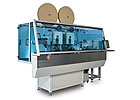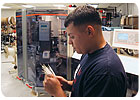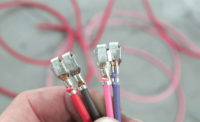
In the past, it was typical to see production batch sizes for automatic termination machines of between 1,000 and 5,000 pieces, or more. Most companies would simply make a large batch of parts and then inventory them until they were needed.
Today, because of lean manufacturing and just-in-time production practices, the manufacturing environment is very different. Now, a “large” batch size can be just 200 to 500 pieces. Some companies have average batch sizes of 50 pieces or less.
In addition, automation continues to increase, with machine production rates that are higher than ever. In fact, for many manufacturers, setup time is more than run times. As a result, reducing setup times and increasing machine utilization is critical to today’s wire-processing companies.

Higher-quality materials may be more expensive upfront, but they can reduce costs in the long run by allowing a termination machine to operate more effectively.
Planning Ahead
In practice, many companies try to minimize the number of changes by grouping jobs according to the part number of the terminal or connector being used. However, these same companies will often overlook the role different terminal types play in terms of changeover times.Changing from an open-barrel to a closed-barrel terminal, for example, takes much longer than changing from a closed-barrel to an open-barrel configuration. As a result, sequencing terminal types to accommodate these kinds of differences, as opposed to simply splitting up jobs by terminal number, can yield considerable time savings.
Along these same lines, many companies will do a good job of planning, but then fail to prepare as they should in anticipation of actual changeovers. With all the necessary materials at hand, operators should be able to change a machine setup-even on older systems-in as little as 5 or 10 minutes. However, it is not uncommon for setup changes to take 30 or 40 minutes, because the operator has to search for materials. Meanwhile, the machine is sitting idle on the production floor.
The most efficient companies will have a system whereby all the requisite materials for a job will be gathered together and brought to the machine before the job actually needs to be run. Depending on the number of machines it owns, the company may have even dedicated operators whose only job is to supply machine operators with the materials they need. These companies will ensure that their applicators, or tooling, are also well organized, so that they will be easy to locate and install.
Granted, this approach will incur some additional costs. But, if a company’s machines are being changed out 20 or 30 times a day, the increased machine utilization may pay for those employees faster than you think.

An easy way to minimize setup times is to have all materials and tooling ready to go before the operator begins making the actual changeover.
Applicator Preparation
All too often, operators and technicians find themselves making applicator adjustments on the machine. Imagine, though, how much downtime could be eliminated if this were done ahead of time.The most efficient companies have a dedicated tooling area where applicators are set up and inspectedbefore the operators need them-with crimp height and pull tests performed and verified well in advance. That way, when the applicator goes to the production floor, it is ready to run. This approach works well not just with automated machines, but also with benchtop crimping presses.
In the latter case, all crimping presses need to be calibrated with identical shut heights. Many of today’s presses have electronic crimp height control, but shut heights should still be calibrated to a standard. That way, once tooling technicians have set up an applicator for one press, it can be moved to another press without having to be readjusted.
The most common standard for press shut height is 5.346 inches, or 135.78 millimeters. Whatever the standard, the main goal is that shut height be the same on all presses.
Another factor to keep in mind is compatibility between applicators and crimp-force monitors. Many manufacturers unfamiliar with crimp monitors will overlook this consideration. As a result, in the event an applicator is not in good condition, there may be excessive variation in crimp-force curves. This, in turn, may cause the monitor to “see” erroneous good-bad signals due to the state of the applicator as opposed to the quality of the crimp.
With this in mind, tooling technicians should evaluate the condition of all applicators and tooling at the end of each job.

Machine changeover times can vary dramatically depending on the terminal types involved.
Material Quality
Because automated wire-terminating machines are built under the assumption that the wire being used will be relatively straight and concentric, flat or curled wires can often be difficult to work with. Curled wire-which results from being wound around a narrow spool-can affect feeding and termination quality, whether crimping, tinning or sealing. Nonconcentric wire can be difficult to strip properly.Sometimes a company will try to save money by purchasing less expensive wire. However, lower price can also mean lower quality, which will result in lower productivity. Nonconcentric wires, in particular, can not only reduce throughput, but increase costs as a result of any extra quality checks that may be required. In many cases, lower-cost wire will actually be more expensive in the long run.
Along these same lines, when working with an automated machine, barreled wire is always preferred over spooled, because it has less curl. This is especially true as you get to the end of a spool with a small inner core. Consistently terminating closed-barrel terminals on curly wire can be virtually impossible.
Spooled wire also usually requires a prefeed. Although in some cases the prefeed can relieve some of the wire’s “memory,” the threading and unthreading of a prefeed unit during job setup adds to changeover times. In addition, most prefeeding units require slower feed rates, which reduce the productivity of the automatic termination machines they serve.
Of course, there are always exceptions to the rule, and some barreled wire can also be very curly, depending on wire quality and insulation type. Companies that are receiving curly, barreled wire should speak to their vendors to determine if the quality can be improved. In some cases, it may be necessary to invest a little more for higher quality materials so that your terminating machine will be able to provide maximum productivity and maximize return on investment.

Today’s automated wire termination machines are better and faster than ever. But, assemblers need to plan ahead if they want to take full advantage of their machines’ capabilities.
Quality Assurance and Maintenance
The optimal location for all quality assurance (QA) devices is on the termination machine itself. The reason for this is simply that it reduces the amount of time an operator will spend walking over to the QA station or finding and bringing an inspector to the machine.In addition, once QA devices have been integrated into a machine, the machine can be preprogrammed with all nominal test values and tolerances, so that the operators themselves will be able to perform the tests quickly and efficiently. QA engineers will also be able to implement tighter control over their test processes by removing any operator judgment during the test. The result is less room for error.
Regular preventative maintenance (PM) is also essential if a machine is to perform to its full potential. The easiest and most important PM is regular cleaning. This can be done by simply having the operator take 10 minutes at the end of each shift to clear away dust and any other accumulated debris. The best way to do this is with a vacuum. Many companies use compressed air, but compressed air will often just blow the debris into or onto another part of the machine instead of removing it completely.
Every machine will come with a recommended PM program. However, it may be necessary to modify this program based on the environment in which the machine is being used and the kinds of applications it is running. If the production area is dirty or dusty, operators should be especially careful in their upkeep. Similarly, tinning applications require much more PM than simple crimping.
PM programs can be purchased from most manufacturers. Periodic reviews and calibrations by qualified technicians will also serve to keep your machine in top condition and reveal any potential problems before they have a chance to become major ones.
Training and Networking
Ongoing training can be extremely helpful with regard to reducing learning curves and maximizing machine efficiency. In fact, whenever a company purchases a new machine, it should organize additional training as soon as possible after installation. The more operators know about their equipment, the more efficient they will be.For example, untrained operators will often slow down their machines when faced with a production problem. However, while this may be necessary in some situations, in many cases, it merely circumvents the root cause. With more training, operators will be able to find the real source of a problem.
Similarly, it is important that companies invest in adequate service training. Higher-level training, in particular, can increase machine uptime considerably over the long term. Ideally, your technicians should be as autonomous as possible, so that they can troubleshoot machine problems without having to resort to the manufacturer’s technicians.
Finally, if your termination machines have the capability, networking can significantly increase productivity. In some cases, it can virtually eliminate the need for the individual operator to program jobs into the machine, drastically reducing setup times. Jobs can be created and the allocated entirely off-line. All job parameters can be downloaded directly to the equipment, so that all the operator has to do is call up the job, quickly verify the setup and start running production.
